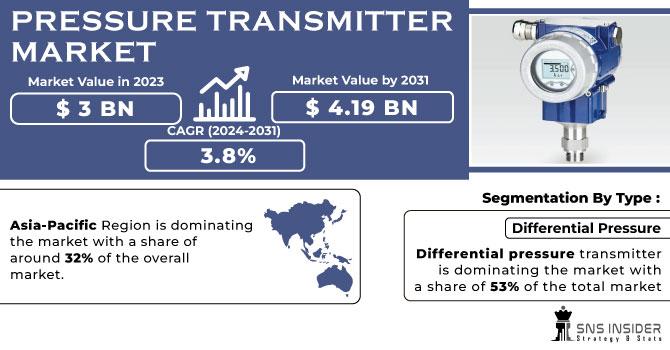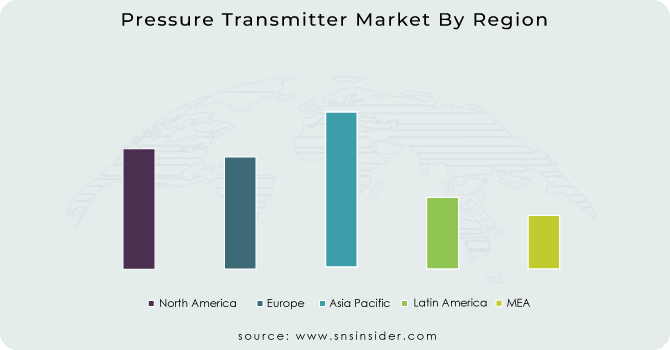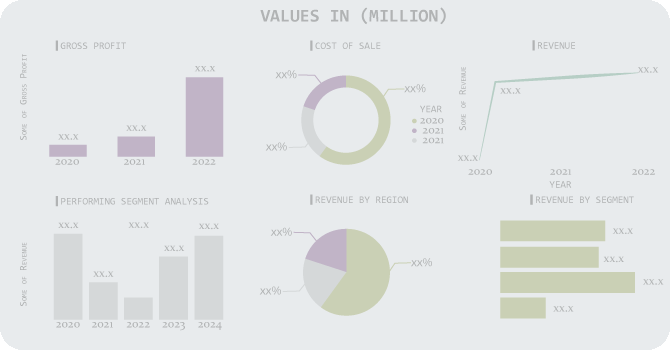Pressure Transmitter Market Report Scope & Overview:

Get More Information on Pressure Transmitter Market - Request Sample Report
The Pressure Transmitter Market Size was valued at USD 3 Billion in 2023 and is now anticipated to grow USD 4.19 Billion by 2031, displaying a compound annual growth rate (CAGR) of 3.8% during the forecast Period 2024-2031.
The pressure transmitter market is growing at a significant rate, with the widespread usage of automation systems like pressure transmitters in eliminating human interaction in the processes. These machines can survive in any weather condition which even includes immersion in fluids like water.
Also, pressure transmitters helps in monitoring and capturing of useful data in order to boost productivity, pattern spotting and even implementing the changes in order to avoid any unfortunate incidents in future. Pressure transmitters are also used in variety of industries ranging from oil and gas to food and beverages industry. The increasing demand for predictive maintenance and real-time data analysis will drive pressure transmitter market revenue expansion. Furthermore, with the integration of industrial internet of things (IIoT) and industry 4.0 into industries will help in the growth of the pressure transmitter market into expansion.
Pressure Transmitter Market Dynamics
Drivers
- Rise in importance towards industrial automation for optimum utilization of resources
- Advancements in automated & remote calibration for reliable and accurate outputs is driving the growth of the market.
Restraints
- Requirement for constant maintenances and frequent software upgrades of the system.
Pressure transmitters need to be constantly updated and maintained based on changing requirements. Implementation of industrial automation has promoted digital transformation but also has increased the complexity of the measurement and analysis of parameters. Even the productivity increases, the complexity of staying up to date with continuous upgrades becomes inevitable in order to avoid failures & downtimes.
- Severe competition from low cost alternatives which may offer basic functionalities but at lower price can be a restraint in the growth of the market.
Opportunities
- Increasing demand for multi-variable pressure transmitters
Increase in demand is because of its ability to measure and calculate the mass flow as a function of absolute pressure, temperature and differential pressure. The key benefit is to have only one device rather than having several transmitters and a mass flow calculator. The transmitters help improve productivity, increase process efficiency, and enhance plant safety while significantly lowering the total cost of ownership is helping in the growth of the market.
- Increased focus on energy efficiency and sustainability helps in creating demand for pressure transmitters which can help in the optimization of processes and reduce energy consumption.
Challenges
- Increased competition from players in unorganized sector and gray market.
- Integrating pressure transmitters with existing systems and automation infrastructure can be a complex process which can be a challenge in the growth of the market.
Impact of Russia-Ukraine War
The Russia-Ukraine war has heavily impacted the market, with the disrupted supply chain which is impacting the pressure transmitter market in variety of ways. Russia has limited its access to raw materials required for the manufacturing of pressure transmitters causing shortages and ultimately price hikes. With the disrupted logistics because of the war is also delaying the deliveries of products which is affecting the projects that heavily relies on pressure transmitters. Also, with a shifting focus towards defense the resources may get diverted from industries like oil & gas which is major user of pressure transmitters which can lead to a decline in demand. But, on the other side some regions might see a rise in demand for pressure transmitters from an alternative suppliers. Also, some countries may even start to manufacture domestically to reduce its dependence on foreign suppliers. The war also raises the problem of energy security so pressure transmitters can help in optimizing energy production and distribution which could lead to increased demand for pressure transmitters in the long run.
Impact of Economic Slowdown
The economic slowdown has a huge impact on the pressure transmitter market With a decrease in demand because of Tight budgets by companies which could delay or even cancel the procurement of new pressure transmitters. Pressure transmitters is an additional equipment meaning that the investment on the equipment can be delayed. The slowdown has caused a disruption in supply chain. Pressure transmitters rely on varieties of raw materials, and slowdown can lead to shortages due to production downturns or even trade restrictions. Which will affect the availability and inflating the prices. But, on the other side focusing on maintaining existing equipment, there may be seen a rise in demand for spare parts and replacements in order to keep the equipments operational. Furthermore, companies may even try to prioritize efficiency so by upgrading to advanced pressure transmitters cost savings strategy. There might be mixed impacts of the slowdown but the overall efficiency make it favourable throughout.
KEY MARKET SEGMENTATION
By Type
- Absolute
- Gauge
- Differential Pressure
- Multivariable
Differential pressure transmitter is dominating the market with a share of 53% of the total market because of its versatility in flow, level & pressure measurement applications which is of great importance in monitoring & control of processes. Differential pressure transmitters can be of any pressure sensing technologies and find their usage in level detection and flow measurement with the help of primary elements such as orifice plates, venturi tubes, flow nozzles, low loss flow tubes, and pivot tubes etc. in industries.
By Fluid Type
-
Liquid
-
Gas
-
Steam
The Liquid Fluid type is dominating the market with a share of 75% of thee total market because of its extensive use in non-hydrocarbon liquids, fluid pressure and level measurement applications like water & wastewater applications, a submersible pressure transmitter finds wide usage. Gauge and differential pressure transmitters are widely used to measure the hydrostatic level of liquids in tanks and used for water level measurement of groundwater pumps.
By Application
-
Level
-
Pressure
-
Flow
Pressure Transmitter Market Regional Analysis
Asia-Pacific Region is dominating the market with a share of around 32% of the overall market. With the growing demand for electricity, exports of chemicals, and development of industrial and utility-grade wastewater treatment plants are driving the growth of the market in the region. Also with the rapid growth of chemical and food & beverage industry is making a dominance in the market.
North America is the fastest growing region next to Asia-Pacific because of rapid industrialization and rapid growth of the healthcare sector.

Get Customized Report as per your Business Requirement - Request For Customized Report
Regional Outlook
North America
-
US
-
Canada
-
Mexico
Europe
-
Eastern Europe
-
Poland
-
Romania
-
Hungary
-
Turkey
-
Rest of Eastern Europe
-
-
Western Europe
-
Germany
-
France
-
UK
-
Italy
-
Spain
-
Netherlands
-
Switzerland
-
Austria
-
Rest of Western Europe
-
Asia Pacific
-
China
-
India
-
Japan
-
South Korea
-
Vietnam
-
Singapore
-
Australia
-
Rest of Asia Pacific
Middle East & Africa
-
Middle East
-
UAE
-
Egypt
-
Saudi Arabia
-
Qatar
-
Rest of the Middle East
-
-
Africa
-
Nigeria
-
South Africa
-
Rest of Africa
-
Latin America
-
Brazil
-
Argentina
-
Colombia
-
Rest of Latin America
Key Players
The major key players are Emerson Electric Company, Yokogawa Electric Corporation, Endress+Hauser AG, ABB Lid., Honeywell International Inc., Siemens AG, General Electric, Schneider Electric SE, WIKA Alexander Wiegand SE & Co. KG, Dwyer Instruments Inc. and others.
Yokogawa Electric Corporation-Company Financial Analysis

Recent Developments
-
In March 2024, Siemens, announced the expansion of its Sitrans P series pressure transmitter portfolio. The new additions include models specifically designed for harsh environments like offshore oil rigs or chemical processing plants. These transmitters boast enhanced corrosion resistance and can withstand extreme temperatures and pressures.
-
In February 2024, Yokogawa, launched a subscription-based service called "OpreX Lifecycle Management for Pressure." This service provides remote monitoring, diagnostics, and maintenance recommendations for Yokogawa pressure transmitters. The subscription model allows companies to access these functionalities without a significant upfront investment.
| Report Attributes | Details |
|---|---|
| Market Size in 2023 | US$ 3 Billion |
| Market Size by 2031 | US$ 4.19 Billion |
| CAGR | CAGR of 3.8 % From 2024 to 2031 |
| Base Year | 2023 |
| Forecast Period | 2024-2031 |
| Historical Data | 2020-2022 |
| Report Scope & Coverage | Market Size, Segments Analysis, Competitive Landscape, Regional Analysis, DROC & SWOT Analysis, Forecast Outlook |
| Key Segments | • By Type (Absolute, Gauge, Differential Pressure, Multivariable) • By Fluid Type (Liquid, Gas, Steam) • By Application (Level, Pressure, Flow) |
| Regional Analysis/Coverage | North America (US, Canada, Mexico), Europe (Eastern Europe [Poland, Romania, Hungary, Turkey, Rest of Eastern Europe] Western Europe] Germany, France, UK, Italy, Spain, Netherlands, Switzerland, Austria, Rest of Western Europe]), Asia Pacific (China, India, Japan, South Korea, Vietnam, Singapore, Australia, Rest of Asia Pacific), Middle East & Africa (Middle East [UAE, Egypt, Saudi Arabia, Qatar, Rest of Middle East], Africa [Nigeria, South Africa, Rest of Africa], Latin America (Brazil, Argentina, Colombia, Rest of Latin America) |
| Company Profiles | Emerson Electric Company, Yokogawa Electric Corporation, Endress+Hauser AG, ABB Lid., Honeywell International Inc., Siemens AG, General Electric, Schneider Electric SE, WIKA Alexander Wiegand SE & Co. KG, Dwyer Instruments Inc. |
| Key Drivers | • Rise in importance towards industrial automation for optimum utilization of resources • Advancements in automated & remote calibration for reliable and accurate outputs is driving the growth of the market. |
| Restraints | • Requirement for constant maintenances and frequent software upgrades of the system. • Severe competition from low cost alternatives which may offer basic functionalities but at lower price can be a restraint in the growth of the market. |

